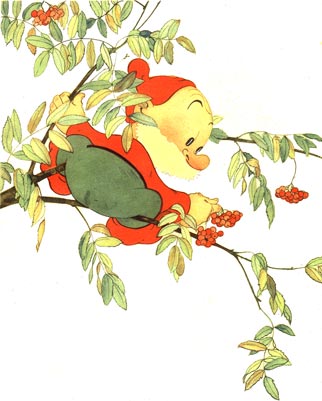All-round artist Jean Dulieu is the creator of the famous little goblin 'Paulus de Boskabouter'. He was born as Jan van Oort in Amsterdam, as the son of singer Hendrik van Oort. Before his days as a comic artist, he played the violin in the Amsterdam Opera Orchestra, and then the second violin in the Concertgebouworkest, The Netherlands' most famous orchestra. But he left the orchestra during the Hunger Winter of 1944 to become a draftsman, inspired by his grandfather Johan Braakensiek who was an illustrator for De Groene Amsterdammer.
'Paulus De Boskabouter', 'Prof Punt'.
Dulieu developed a couple of goblins, and shortly afterwards 'Paulus de Boskabouter' was born. The first of about 8,000 episodes of the 'Paulus' strip appeared in newspaper Het Vrije Volk in 1946. This first series ran until 1957, and was followed by a second series from 1963 until 1967. After another hiatus, Dulieu made 23 new stories for local papers like Zeeuwse Courant, Gelderse Courant, Apeldoornse Courant and Arnhemse Courant between 1973 and 1984. All stories were characterized by the artist's large imagination and love for nature. Over the years, many classic side characters were introduced, such as Oehoeboeroe the owl, Pieter de Veldkabouter, Salomo the raven, Gregorius the badger and the evil witch Eucalypta. Book collections were published by De Arbeiderspers, and later by C. P. J. van der Peet, Ploegsma, Leopold and De Meulder.
Early 'Paulus De Boskabouter' strip from 1947.
Being a versatile artist allowed Jean Dulieu to use his Paulus character in various projects: illustrated stories, puppet shows, radio plays, puppet movies, animated movies and of course, in his comics. All of those projects (except the puppet movies) he made (almost) completely on his own. While 'Paulus' appeared in black-and-white in newspapers, he could be read in full-color in magazines like Kris-Kras, De Varagids, Eva, Fix en Fox, Margriet, Avrobode, Bobo and Striprofiel. His numerous stories have been translated into German, English, Swedish and Japanese.
While 'Paulus' remained his main focus throughout his entire career, Dulieu has also worked on a couple of other projects. For the grocery stores of Albert Heijn, he illustrated 'Boffie en Buikie In de Knoop' (1953), a picture album with 96 collectable images starring the mascot of the company's own coffee brand. Customers received the pictures when they did their groceries in one of the Albert Heijn stores. The story is rather simple. The friendly coffee waiter Boffie has all sorts of strange adventures with a strange professor called Buikie. Of course, everything comes to a happy end with a nice cup of coffee. Ever since the start of the 20th century, similar albums with collectable images had been an important marketing tool for Dutch brands, especially from the Zaan area, such as Verkade and Hille. The region's bigtime grocer Albert Heijn didn't step in until 1953, with the 'Boffie' book as their second publication. However Dulieu wasn't the first to illustrate stories with Boffie. In 1947 Huibert Vet had already illustrated six booklets, containing the story 'Boffie en de Verdwenen Koffie'.
In 1956, Jean Dulieu published a book about the life of St. Francis of Assisi. Two other novels by Dulieu, 'Maledictus' (1954) and the autobiographical 'Verspeelde muziek' (1967), remained unpublished. He also appeared as ventriloquist 'Koning Noppie' in the TV series 'De Mallemolen' in 1956-1957.
Jean Dulieu's work has been awarded many times. He received the Literature Prize of the Youth Friends Association of New York. In 1962 one of his stories, 'Paulus De Hulpsinterklaas', won the prize for best Dutch children's book. The same story received another award that same year, when a vinyl record adaptation by Dulieu won the audiovisual Edison award for "Best Children's Record". He lived in reclusion after his wife's death in the late 1980s, and passed away in Arnhem at the age of 85 in November 2006.
In 2012, Dorinde van Oort published a biography of her father, called 'Paulus de Boskabouter, of Het Dubbelleven van Jean Dulieu'. It dealt with Dulieu's life, his careers as both a musician and artist, his religion and the often troubled relationships he held with his family and friends. On 20 September 1981 he received the Stripschapprijs from comic appreciation society Het Stripschap.
Jean Dulieu was an influence on Dick Vlottes. In the Dutch city Almere a road was named after Jean Dulieu, a street after Eucalypta and a court after Paulus de Boskabouter, all part of the "Comics Heroes" district. Since 2016, Jean Dulieu has a bridge named after him in the city of Amsterdam.
Lambiek will always be grateful to Dulieu for illustrating the letter "P" in our encyclopedia book 'Wordt Vervolgd - Stripleksikon der Lage Landen', published in 1979.
'Paulus De Boskabouter'.
Paulus de Boskabouter site
(in Dutch)








